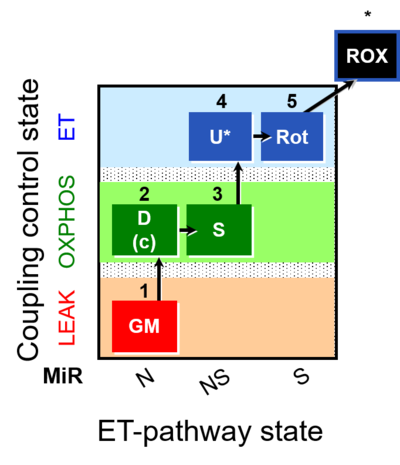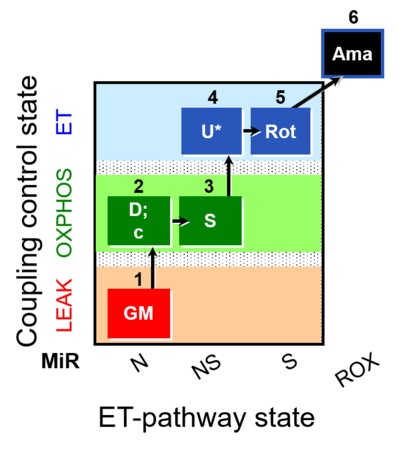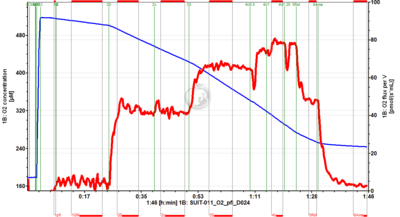Difference between revisions of "SUIT-011"
From Bioblast
| Line 6: | Line 6: | ||
::: '''[[Categories of SUIT protocols |SUIT-category]]:''' NS(GM) | ::: '''[[Categories of SUIT protocols |SUIT-category]]:''' NS(GM) | ||
::: '''[[SUIT protocol pattern]]:''' diametral 1GM;2D;2c;3S;4U;5Rot- | ::: '''[[SUIT protocol pattern]]:''' diametral 1GM;2D;2c;3S;4U;5Rot- | ||
The SUIT-011 protocols are designed for cells or tissue types that either display a preference for [[GM_pathway_control_state |GM]] over [[PM_pathway_control_state |PM]] to support NADH-linked respiration or is used in comparison with [[SUIT-004]] to evaluate whether such a preference exists. SUIT-011 protocols provide a quick assessment of the linear coupling control ([[LEAK-respiration|''L'']]-[[Oxidative phosphorylation| ''P'']]-[[ET-capacity| ''E'']]) with NADH linked-substrates ([[GM_pathway_control_state|GM]]) and the control in ET state ([[NADH_Electron_transfer-pathway_state|N]], [[NS-pathway control state| NS]], [[Succinate pathway control state| S]]), covering the contribution of two pathways which are most important in the mitochondria of many species, tissues and cell types. | |||
SUIT-011 can be extended with the CIV assay module. | |||
__TOC__ | __TOC__ | ||
Communicated by [[Doerrier C]] and [[Gnaiger E]] (last update 2019-01-31) | Communicated by [[Doerrier C]] and [[Gnaiger E]] (last update 2019-01-31) | ||
Revision as of 09:52, 5 February 2019
Description
Abbreviation: NS(GM)
Reference: A ![]() »Versions
»Versions
- SUIT-category: NS(GM)
- SUIT protocol pattern: diametral 1GM;2D;2c;3S;4U;5Rot-
The SUIT-011 protocols are designed for cells or tissue types that either display a preference for GM over PM to support NADH-linked respiration or is used in comparison with SUIT-004 to evaluate whether such a preference exists. SUIT-011 protocols provide a quick assessment of the linear coupling control (L- P- E) with NADH linked-substrates (GM) and the control in ET state (N, NS, S), covering the contribution of two pathways which are most important in the mitochondria of many species, tissues and cell types. SUIT-011 can be extended with the CIV assay module.
Communicated by Doerrier C and Gnaiger E (last update 2019-01-31)
Specific SUIT protocols
- SUIT-011 O2 pfi D024 for permeabilized fibers
References
Steps and respiratory states
| Step | State | Pathway | Q-junction | Comment - Events (E) and Marks (M) |
|---|---|---|---|---|
| 1GM | GML(n) | N | CI | 1GM
|
| 2D | GMP | N | CI | 1GM;2D
|
| 2c | GMcP | N | CI | 1GM;2D;2c
|
| 3S | GMSP | NS | CI&II | 1GM;2D;2c;3S
|
| 4U | GMSE | NS | CI&II | 1GM;2D;2c;3S;4U
|
| 5Rot | SE | S | CII | 1GM;2D;2c;3S;4U;5Rot
|
| 6Ama | ROX | 1GM;2D;2c;3S;4U;5Rot;6Ama
|
| Step | Respiratory state | Pathway control | ET-Complex | Comment |
|---|---|---|---|---|
| ## AsTm | AsTmE | CIV | CIV | |
| ## Azd | CHB |
- Bioblast links: SUIT protocols - >>>>>>> - Click on [Expand] or [Collapse] - >>>>>>>
- Coupling control
- Pathway control
- Main fuel substrates
- » Glutamate, G
- » Glycerophosphate, Gp
- » Malate, M
- » Octanoylcarnitine, Oct
- » Pyruvate, P
- » Succinate, S
- Main fuel substrates
- Glossary
Strengths and limitations
- Comparison of GM- with PM-capacity yields important information on N-pathway respiratory control upstream of CI (Lemeux et al 2017; Votion et al 2012).
- A succinate concentration of >10 mM may be required for saturating SE capacity.
- Rox might be inhibited slightly further by inhibition of CIV by cyanide (KCN; 1 μM). But cyanide inhibits not only CIV, but also catalase and other oxygenases involved in ROX.
- + NS-OXPHOS capacity provides a physiologically relevant estimate of maximum mitochondrial respiratory capacity.
- + Glutamate is easier to prepare compared to pyruvate.
- + Application of the cytochrome c test early in the protocol ensures comparability of all states in case of any effect of c.
- + Reasonable duration of the experiment.
- - GM and PM yield typically identical fluxes in human skeletal muscle fibres. However, PM is the superior alternative to GM: the fraction of the N-pathway is lower and of the S-pathway is higher with GM compared to PM (GMP is inhibited by the CII inhibitor malonic acid to a larger extent than PMP). PM, therefore, yields a more sensitive assay for the diagnosis of injuries in the N-pathway, since an impairment of N-pathway capacity can be compensated partially by activation of the S-pathway. This is a disadvantage compared to SUIT-004 and SUIT-008 for diagnosis of N-capacity.
- - To detect an additive effect of P after GMP, pyruvate would have to be added as step 3 (before S). However, inhibition of respiration was observed after titration of P (5 mM) in horse skeletal muscle fibres (Votion et al 2012), which was not the case when P was titrated in steps of 1 mM.
- - When evaluating the additive effect of the N- and S-pathway, it has to be considered that NSP- and NSE-capacities can only be compared with NP- and SE-capacities. This is not a problem when NSP = NSE (Gnaiger 2009). Otherwise, it may be assumed that SP = SE (Votion et al 2012), such that NSP can be compared with NP + SP. SUIT-004 should be chosen for the additive effect in the ET-state.
- - Rox may be lower in substrate states earlier in the SUIT protocol. Therefore, this Rox measurement is frequently taken as a methodological control rather than as the final basis of Rox correction of mitochondrial respiration (mt).
- - Careful washing is required after the experiment to avoid carry-over of inhibitors and uncoupler.
- - CIV activity is not measured, to save experimental time.
Compare SUIT protocols
- GM and PM yield typically identical fluxes in human skeletal muscle fibres.
- SUIT-004 1PM;2D;3U;4S;5Rot-
- SUIT-008 1PM;2D;3G;4S;5U;6Rot-
- 1PM;2D;3U;4G;5S;6Oct;7Rot;8Gp-
- 1PGM;2D;3S;4U;5Rot-
MitoPedia concepts: MiP concept, SUIT protocol, Recommended
MitoPedia methods:
Respirometry




